Laundry-to-landscape system

Invented by greywater pioneer Art Ludwig, the laundry-to-landscape (L2L) greywater system is one of the most popular types of systems in the U.S.
I’ve helped install hundreds of these in workshops and trainings and can’t imagine living without one. It can be built with off-the-shelf parts, doesn’t alter the household plumbing, and doesn’t require a permit in many states. The system captures greywater from the drain hose of the washing machine, connects to a diverter valve so you can easily switch the system on or off, and then distributes greywater into the landscape through a main line of 1-inch irrigation tubing and 1⁄2-inch branch lines that feed specific plants. It is one of the easiest systems to construct, and is very easy to change.
This chapter will lead you through the specifics of how to design and install your own L2L system. I’ll also discuss where to source materials, what maintenance is required, and how to construct the mulch basins.

To prepare for constructing the system, you’ll determine where to run the pipe from the washing machine out to the landscape, what plants are easiest to irrigate, and how many plants you can irrigate based on your home’s greywater production. By choosing nearby plantings or those downhill of the home, you’ll design the system so the washing machine’s internal pump is not overtaxed. The type of washing machine you have will impact the system: conventional top-loaders can distribute greywater to more locations than front-loading machines and most high-efficiency top-loaders.
Note: If your home generates large volumes of greywater, be sure to read Got a Lot of Greywater? Got a Lot of Greywater? Don’t Dig One Big Basin. and Irrigating with Multiple Zones for advice on appropriately distributing larger flows.
If you’re planning to install a gravity-fed branched drain system as well as an L2L system, it’s wise to first plan the irrigation portion of the gravity system before deciding what to irrigate with the L2L system. The reason? It’s much easier to distribute water from an L2L system than a gravity one, and you’ll have more options for the L2L. See here for guidance on designing a branched drain system. In general, if one area in the landscape will receive greywater from both types of systems, direct greywater from the branched drain system to irrigate the closest trees and bushes, and use the L2L system to serve slightly more distant plants or smaller plants in the vicinity.
The washing machine pump pushes greywater through the L2L irrigation system at low pressures. Each time the machine pumps it sends all the water inside the washer drum to the landscape, then the pump turns off. Because of this, the system is limited in how many outlets it can have; if there are too many, it’s impossible to get water to come out of them all. You can always have fewer outlets, but including more may require a lot of adjusting to achieve an even flow of water — if it’s even possible. Here are some general guidelines on the limitations of different types of machines.
If you are purchasing a new washing machine, you may be wondering whether installing this system could affect your washing machine warranty. The answer: Perhaps, but probably not. My personal and anecdotal experience is that washer repair people don’t question the greywater system or attribute any washer problems to it. I know of just one instance when the company’s installer of a new washer didn’t want to hook it up to the pre-installed 3-way diverter valve, claiming it would void the warranty on the machine. Others have experienced the opposite: the installer helpfully hooked up the new washer to the valve.
Identify planted areas suitable for L2L irrigation (trees, bushes, larger perennials, or large annuals). Then, consider where the irrigation pipe from the washing machine can exit the house, either through the wall or crawl space. Can you exit near a suitable irrigation area? If not, are there other exit options (for example, crossing to another side of the house through the crawl space)? Also consider landscape alterations to make the installation easier: for example, planting trees or bushes in an accessible part of the yard.
The washing machine pump can send greywater directly to the landscape, but not too far away or up a hill. Overworking the machine’s pump could damage it. Since replacing a washer pump is a lot cheaper and easier to do than buying and installing an effluent pump system, some people whose yards are gently sloped choose to overwork their machine’s pump slightly rather than installing a pumped system. These general guidelines will help you select an appropriate part of your landscape, but remember that each situation is different; change the system if you notice problems with the machine. If your machine doesn’t drain well or has other pump problems, fix them before installing an L2L system.

Distributing water to landscapes with different slopes, using an L2L system
There’s a wide range of recommendations among different state greywater codes regarding where to direct greywater — either on the surface of the landscape or delivered deep belowground. Because most of the plants’ roots, as well as the soil microorganisms that clean greywater, are found in the upper 1 to 2 feet of soil, surface irrigation is usually better. (Remember, greywater must land onto mulch, never bare soil.) It’s also a lot easier to observe and maintain the system when greywater outlets are aboveground; people are less likely to forget to check the outlets since they’re visible, and maintenance is easier as well.
Surface irrigation isn’t always possible, though. Some codes don’t allow it, and often gravity-branched drain systems must have outlets below grade due to the slope of the land. Whenever you need to irrigate subsurface, try to stay as close to the surface as you can. Some states require that outlets are covered but not necessarily below grade. For example, California’s code requires a 2-inch covering, including a “solid shield,” so the outlet can be on the surface covered by a mulch shield.
For details, see Irrigation Options.
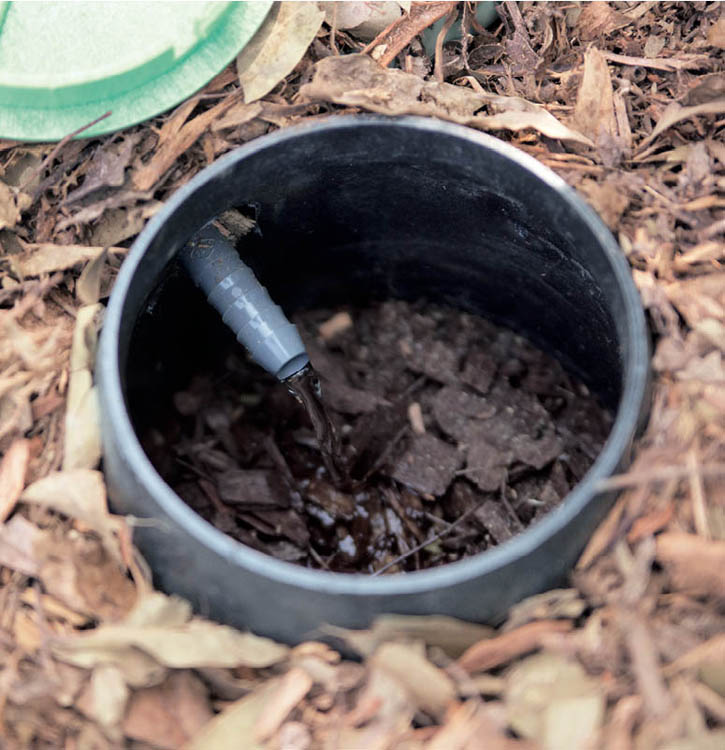
Subsurface irrigation into a mulch basin. A lid (not shown) covers the outlet.
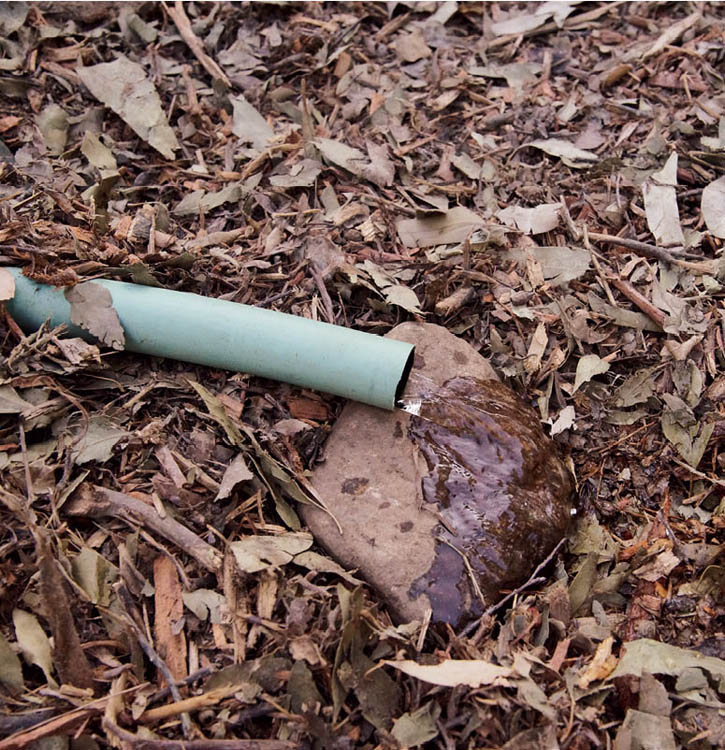
Surface irrigation into a mulch basin

Surface irrigation Greywater drops through the air and lands onto mulch, where it’s quickly soaked up.
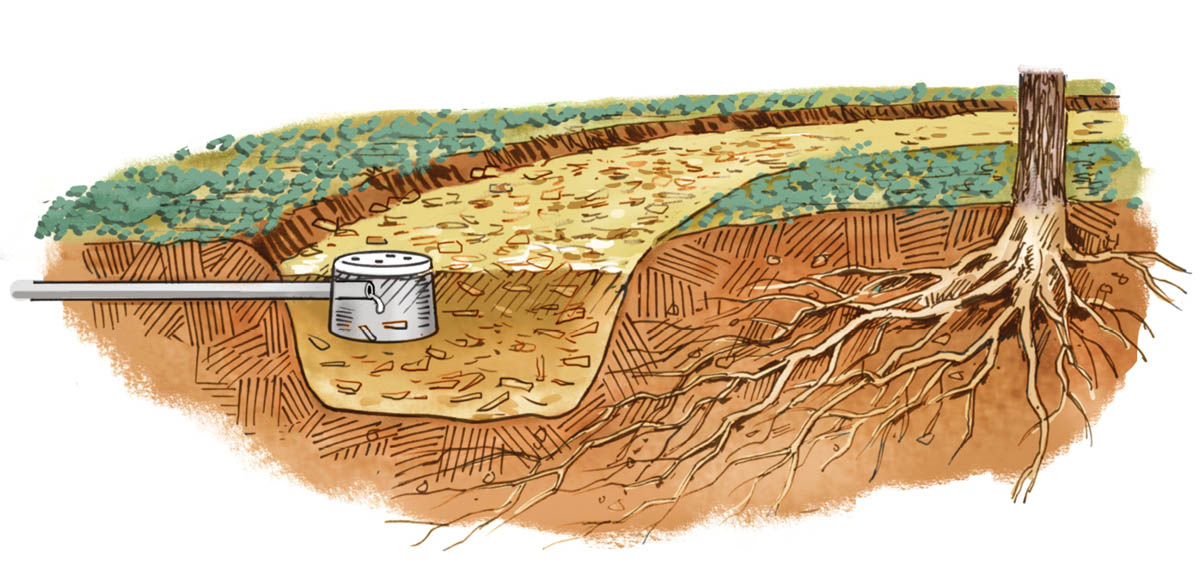
Subsurface irrigation A mulch shield protects the greywater outlet and water is released below the surface of the mulch.
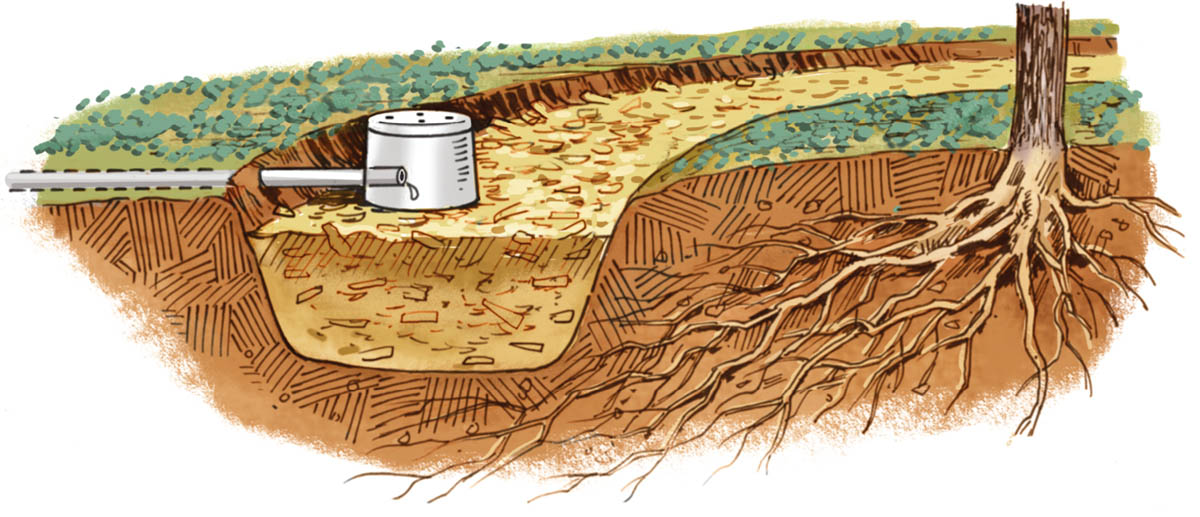
Covered outlet at surface Greywater lands onto mulch at the surface and is covered with a solid shield.
As you’re determining where you’ll send the water — and before beginning construction — make a detailed diagram of the entire system, including the number of bends, length of pipe, etc. This will save you a few trips to the store when you build. Remember that the end of the main tubing can be an outlet and be located in a mulch basin near a plant to be irrigated. Alternatively, if your site requires that the end of the line is capped off, use a fail-safe overflow in the system to protect the machine’s pump (see Overflow Options).
After you’ve installed the system, edit this drawing as necessary to document the “as-built” system. This document, along with the pre-burial photographs, will help you find the buried tubing and outlets in the future. Add all final drawings to your Operation and Maintenance Manual (O&M) manual (see here).

Sketch of system
Most front-loading washing machines have an internal filter to keep large particles out of the pump. Over time the filter clogs, which adds strain on the pump and can prevent it from evacuating all the water from the machine. Before installing a greywater system and anytime the machine struggles to pump out the water, clean the pump filter. Remove the front cover to reach the filter, unscrew the filter cover, and be prepared for a few gallons of water to spill out. Clean out the filter and put it back in place. If you don’t have the owners manual, you can find instructions online for various models of washing machines by searching with the phrase “how to clean your pump filter,” or you can consult a washing machine repair person for assistance.

Greywater pipes can’t run over hardscape. If you need to pass through a driveway, stairs, or a patio to run the pipe to the landscape, you can:
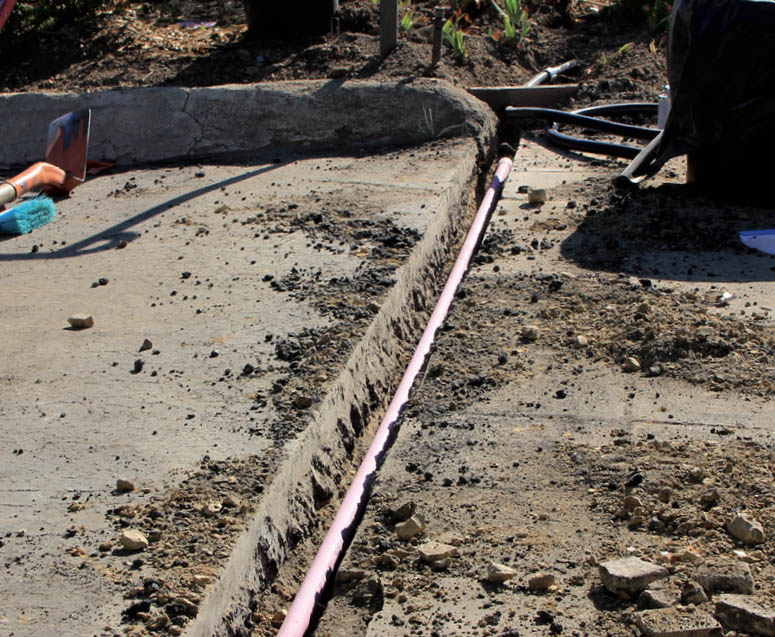
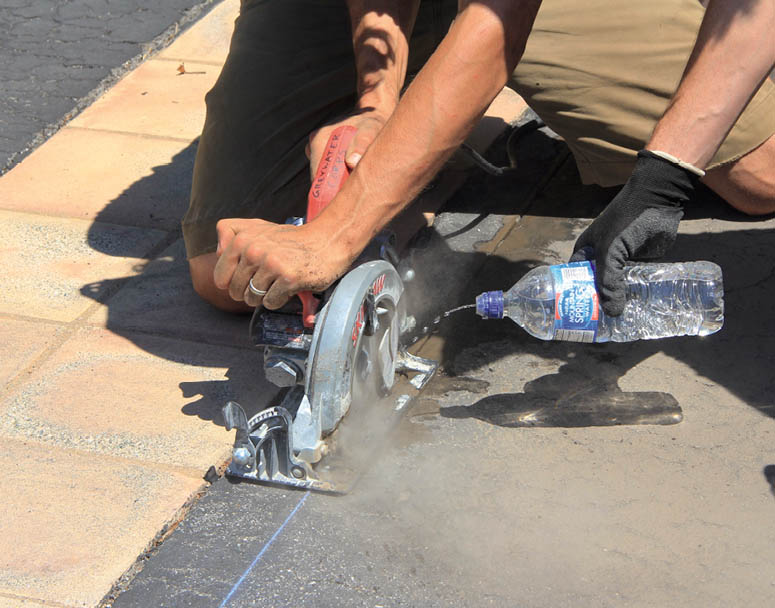

Working pipes around hardscape
Here is an example of an L2L system for a three-person household in Austin, Texas. They wash four loads of laundry a week at 25 gallons a load and never wash more than two loads on any given day. This is the basic information they need to design the irrigation and infiltration area for their system:

When they assessed the site, they found that their existing irrigation system had three zones. One of the zones irrigated five small trees (3-foot radius from trunk to drip line), which were the most suitable plants for an L2L system (the other plants were small and spread out). They could slope the pipe downward as it traveled under the house, then run it 10 feet to reach the first tree; all the trees were within 50 feet of where the pipe traveled flat. This zone of trees seemed to be easiest to irrigate, so they checked to see if the greywater production was a good match for the trees (was it too much or too little water?). In terms of irrigation amount, each tree would receive 100/5 = 20 gallons per week. Austin gets some summer rain to supplement greywater during the hottest time of the year.
They calculated the plant water requirements using both methods from chapter 5, starting here.
Using the “rule of thumb” method, one small tree requires:
πr2 = 3 × 3 × 3 feet = 27 square feet
27 square feet × 1 (hot climate) = 27 gallons per week
Using the ET method, a tree of this size in Austin requires:
0.62 × 27 square feet × 0.5 × 8.21 (ET) = 69 gallons/month or 17 gallons/week
This demonstrates that 20 gallons a week is a good amount of irrigation water for each tree in this climate.
Next, they determined how large each mulch basin should be to infiltrate greywater into the ground. Based on the soil type and gallons per day calculated above, the system requires 30 square feet of mulch basin area. Since the water will be divided among five different trees, each tree needs basin at least 30 ÷ 5 or 6 square feet.
A “second standpipe” system is another option for a washing machine greywater system. It includes a secondary standpipe installed near the washing machine to drain by gravity to the landscape. To switch between the greywater and the sewer/septic systems, you manually move the washing machine’s drain hose from one standpipe to the other.
Second standpipe systems are most commonly used in hot climates that have relatively high water requirements per tree, because it’s harder to distribute greywater to many plants. The irrigation portion of the system is installed with a branched drain configuration system (see Installing a Branched Drain System for installation details).
